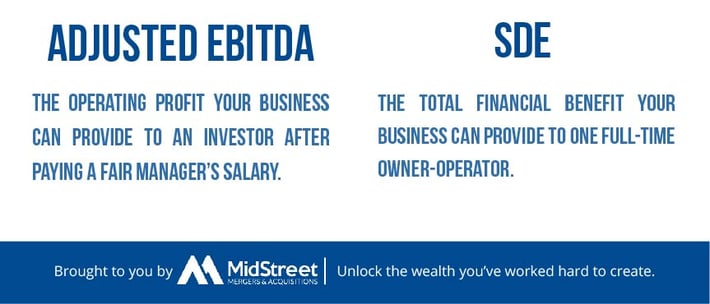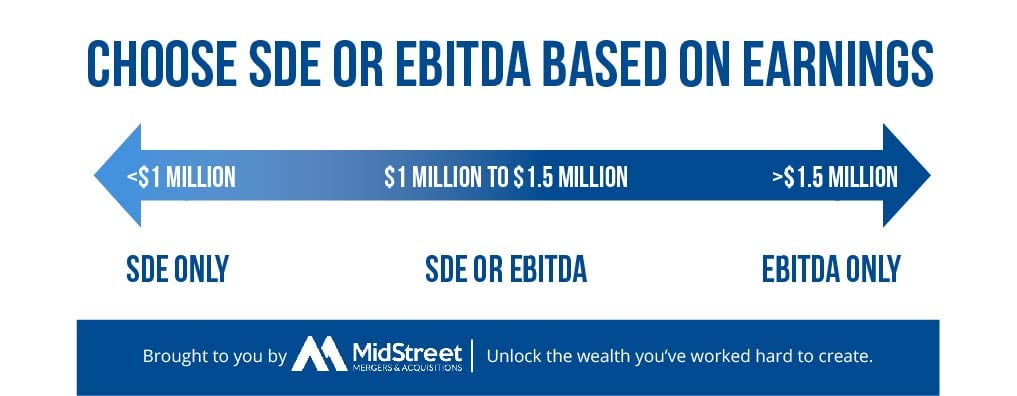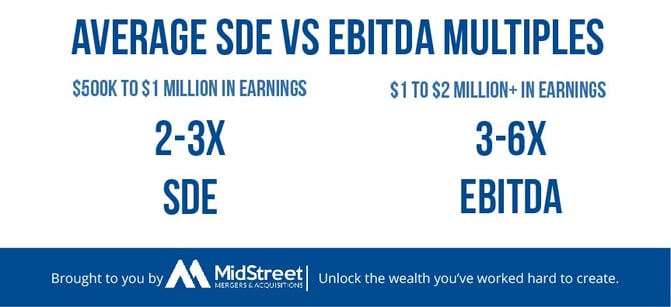EBITDA and Sellers Discretionary Earnings or "SDE" are the two most common metrics used to value a small business.
But, how do they differ, and which one is right for you and your business?
What is EBITDA?
EBITDA stands for Earnings Before Interest, Taxes, Depreciation, and Amortization.
It’s a common measure of financial performance used to value medium to large businesses.
The formula to calculate EBITDA is:
Net Income + Interest Expense + Depreciation Expense + Amortization Expense + Taxes
But, this is regular EBITDA and your business will be valued on a multiple of adjusted EBITDA.
You’ll want to adjust your EBITDA to remove any one-time expenses or revenue streams and normalize your salary.
For example, if you paid yourself $200,000 per year but an acquirer could replace you with a manager earning $100,000, you would add the $100,000 in excess salary.
Throughout this blog, we’ll use the term “EBITDA” to mean your company’s adjusted EBITDA.
For additional examples, read our blog on EBITDA here.
What is SDE?
SDE, or Seller’s Discretionary Earnings, is the most common metric used to value small businesses.
SDE represents the entire financial benefit your business would provide to one full-time owner-operator.
SDE is calculated by taking your business’s net profit and adding back or "recasting" certain discretionary expenses.
NOTE
An "add back" is an expense that is added back to find your SDE. Typical add backs include your owner's salary, your payroll taxes on your salary, interest, depreciation, and any personal expenses paid through the business.Some add-backs are standard, meaning they apply to every business. Other add-backs are situational and depend on the specifics of your business.
For a more in-depth understanding of SDE, read our complete guide to SDE here.
What’s The Difference Between SDE and EBITDA?
EBITDA and SDE measure the performance of your business differently.
EBITDA allows investors to compare your business against others in the same industry by removing expenses that skew a fair comparison.
SDE tells an individual looking to acquire your business how much they would make if they worked full-time in the business.

The primary difference between SDE and EBITDA is in the adjustment for owner’s salary.
Adjusted EBITDA adds back any excessive owner’s salary and benefits over what a manager would make.
Seller’s discretionary earnings adds back your full owner’s salary and benefits to reflect what a full-time owner-operator would earn.
MIDSTREET TIP
If your business has multiple owners, both adjusted EBITDA and SDE will reduce their salary to the level a manager or employee would make performing the same job function.Is EBITDA The Right Metric For Your Business?
The primary factors you should consider when choosing to use SDE or EBITDA are your involvement in the day-to-day of your business, your business’s earnings, and your industry.
Most businesses with $1.5 million in earnings or greater will be valued with a multiple of EBITDA.
Companies this size often sell to private equity groups and strategic buyers who value your company using a multiple of EBITDA.
Most businesses under $1 million in earnings will be valued using seller’s discretionary earnings.
Your business is most likely to sell to an individual buyer if it’s in this size range. Individual buyers prefer to use SDE because it more accurately reflects what they’ll put in their pocket.
Businesses between $1 million and $1.5 million in earnings can use either valuation technique.

If you’re in this $1 million to $1.5 million in earnings range, you can use your involvement in the business and your industry to determine which valuation metric to use.
Private equity groups prefer businesses that are not dependent on their owner and will be expecting you to provide your EBITDA.
If you are an absentee owner or perform a role that a manager could fill, your business will appeal to private equity groups and strategic acquirers.
It’s also important to consider your industry when choosing which valuation method to use.
Individual buyers span all industries depending on the size of the company.
In a 2020 study, Private Equity Info determined the top industries for private equity interest are manufacturing, technology, health care, construction, and logistics.
Any business serving other businesses or with recurring revenue is a hot target for private equity.
SDE vs EBITDA Multiples
Because seller’s discretionary earnings has your salary, benefits, and one-time events added back, it’s higher than your EBITDA.
And because SDE is higher, normal SDE multiples are lower than EBITDA multiples.

Multiples on seller’s discretionary earnings are typically in the 2-3x range but can go as high as 4x if your company is nearing $1 million in SDE.
If your earnings are between $1 million and $2 million, your business is likely to sell for 3-6x EBITDA depending.
If your business has an EBITDA of over $2 million it will likely sell for 4-7X EBITDA, but multiples can extend beyond 7x depending on your size and industry.
The average multiple for a private company of this size selling in Q3 2020 was 4.4 times EBITDA.
Example SDE and EBITDA Calculations
Let’s do an example for a small business.
ABC Manufacturing makes widgets for the automotive industry.
Here are ABC's key financial numbers for the year:
_WebP.webp?width=686&name=EBITDA%20Formula%20(15)_WebP.webp)
The owner's compensation includes all wages, health insurance, vehicle payments, the family vacation, and all other personal expenses run through the company.
The taxes paid for the year were $0 because ABC is an S corporation and does not pay corporate income tax.
Let’s find the EBITDA first.
Take the company’s Net Income ($700,000) and add back the interest ($100,000) and depreciation ($200,000). This leaves an EBITDA of $1,000,000.
Your business is most likely to be valued using a multiple of adjusted EBITDA, which removes above-market owner’s salary.
In this example, the seller paid themselves $250,000 through wages, a vacation, and car payments.
For this company, a manager could be paid $100,000. We’ll add back the other $150,000 as excessive owner’s salary.
This brings the adjusted EBITDA to $1,150,000.
Now let’s find the seller’s discretionary earnings.
We’ll start with the company’s net income ($700,000) and do the same depreciation and interest add backs we did for EBITDA. Then, we’ll add back the full owner’s compensation of $250,000.
This leaves us with an SDE of $1,250,000 for ABC Manufacturing.
In this example, and for most businesses, the main difference between the SDE and adjusted EBITDA is removing a fair market owner or manager’s salary from the cash flow.
This is because SDE is designed to show what an owner-operator would earn, and adjusted EBITDA is designed to show what an investor would earn.
Understand How to Determine The Value of Your Business
If you are thinking about selling your business, it’s critical to understand its value.
Knowing whether to use EBITDA or SDE is one of the first steps in the process.
If you have questions about EBITDA or SDE, or determining your company’s value, feel free to reach out to us today.




